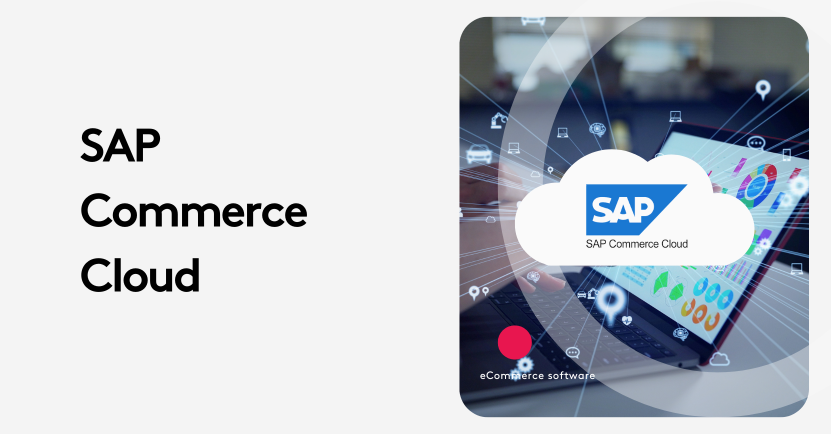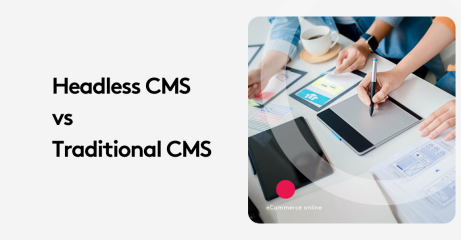The Truth About SAP Commerce Cloud: Pros, Cons & More

SAP Commerce Cloud promises enterprise-grade capabilities—but does it deliver in today’s fast-paced market? We break down its strengths, weaknesses, and what businesses should really consider. While SAP is best known for being the global leader in enterprise resource planning (ERP) software and business AI. And like any other corporation, it has expanded its offering with Commerce solutions.
SAP Commerce Cloud has become undoubtedly one of the leaders in enterprise e-commerce software.
SAP developed its digital commerce software for multiple channels across B2B, B2C, and B2B2C models.
It offers the security and scalability to large enterprises with augmented needs and requirements.
For existing SAP users, embracing SAP Commerce will come as a logical choice for their eCommerce operations.
The advantages of staying in the same ecosystem are indeed valuable and create a cohesive business structure. Of course, there is always an argument against it too.
SAP Commerce is ideal for larger enterprise. But for medium size businesses, it may hinder growth as they usually need more agility and hands on support.
In this article, we will explore the features and benefits of SAP Commerce Cloud. We will also discuss when it makes sense to use this platform - and when it doesn't.
Key takeaways
- Best for Large Enterprises: SAP Commerce Cloud is ideal for large businesses with complex operations, high transaction volumes, and existing SAP system usage.
- Powerful Features: It offers omnichannel support, AI-driven personalization, real-time order management, and industry-specific solutions.
- Strong SAP Integration: Seamless connection with SAP S/4HANA, Marketing Cloud, and Customer Data Cloud enhances efficiency and centralized operations.
- Steep Learning Curve & High Cost: The platform requires technical expertise, has ongoing maintenance costs, and lacks built-in marketing tools, making it less suitable for mid-sized businesses.
On this page:
What is SAP Commerce Cloud?
SAP Commerce Cloud is a robust e-commerce platform with advanced capabilities designed for large corporations and enterprises.
Who is SAP Commerce Cloud Ideal For?
- Large Enterprises: If your company's annual revenue is $50M and above with extensive and complex product catalogs across multiple regions and countries.
- Organizations in the SAP Ecosystem: If you are a user of SAP systems like SAP S/4HANA or SAP Finance. SAP Commerce cloud can seamlessly integrate with your operations to create centralized data sharing and seamless automations. This will reduce inefficiencies, enhances decision-making, and simplifies operations.
- Omnichannel Businesses: If you operate across multiple sales channels: websites, mobile apps, and physical stores—SAP headless capabilities will come in useful.
What Makes SAP Commerce Cloud Stand Out?
- Headless Commerce Flexibility: Offer a branded omnichannel experience wherever your customers shop. SAP Commerce can help you create personalized, unified and consistent experience across all and any sales channel.
- Scalability for Growth: SAP Commerce Cloud will handle any large scale operational demands without a blink. Whether it’s high transaction volumes or the addition of new markets and storefronts.
- Advanced Personalization: With advanced AI features and machine learning, the platform offers predictive product recommendations and personalized marketing.
SAP Commerce Cloud is a great choice for large businesses. It offers a scalable, omnichannel platform with strong integration features
SAP Commerce Features and Capabilities
What are the top features and capabilities make SAP Commerce Cloud stand out? Below are its seven key features and capabilities:
1. Omnichannel Approach
eCommerce has become more than just a website. SAP Commerce Cloud helps enterprises create a consistent experience across websites, mobile apps, marketplaces, social media, and physical stores.
eCommerce businesses can operate and manage several storefronts from one platform, allowing for better targeting and segmentation.
2. Inbuilt Content Management System
With a built in SAP Commerce’s Product Content Management system, businesses can manage their product catalogs easily. Users can organize, enrich, and distribute product data across channels.
3. Personalization Thanks to AI
Thanks to AI tools, SAP Commerce meets customers’ ever-growing demand for personalization and experiences. Customer behavior and preferences are analysed to create recommendations, tailor promotions, and promote content, boosting engagement and conversion rates.
4. Order Management in Real-Time
Meeting customer and operational success needs, SAP Commerce Cloud delivers real-time order management functions so businesses can keep on top of orders and supply chains. The latter function is essential to those with complex high-order chains.
5. Support for Complex Business Models
Designed to handle the needs of B2B, B2C, and B2B2C businesses. If your business is setup to have different branches then SAP can help manage intricate pricing structures, contract-based relationships, and multi-level distribution channels.
6. Solutions for Specific Industries
SAP Commerce delivers solutions for specific wholesale, manufacturing and retail industries. Due to its specialized capabilities, SAP Commerce Cloud can help address customer pain points to ensure businesses operate efficiently and effectively.
7. Headless Capabilities
Customization is important for a great user experience. Headless commerce lets businesses separate the front end from the back end. This way, a business can add new features and quickly adjust to changes in the digital world.
The strong features, including the seven mentioned above, make it one of the top platforms. It helps users worldwide run a great e-commerce business.
SAP Commerce Cloud Benefits
Along with improving digital commerce operations, SAP Commerce Cloud benefits focus on enhancing customer experiences and driving growth. Here are fivw benefits:
1. Focus on the Best in Customer Experience
No doubt that customer experience online drives revenue. Thanks to AI-driven personalization, brands can create ultra-personalized content for their users. This can be product recommendations, promotions, and content based on their preferences and behaviors.
As it can manage multiple channels, SAP Commerce Cloud delivers perfect shopping experiences across all shopping channels and locations.
2. The Scalability and Flexibility That Your Business Needs
SAP is a veteran of enterprise softwares and without a doubt offers extreme scalability fit for larger corporations. It can launch many storefronts and manage a high volume of transactions.
It also offers a headless commerce feature. Going headless means brands have the tools to share content and product information across any sales channel no matter the device.
3. Integration with the SAP ecosystem
As you would expect from the same provider, integrating the digital commerce by SAP to the SAP ecosystem is simple.
This includes SAP S/4HANA, Marketing Cloud, and Customer Data Cloud.
businesses can streamline their workflow through consolidated operations and the easy sharing of data.
4. No Business Model is Too Complex
Whatever your needs, the platform is robust enough to handle even the most complex business models.
From multi-tiered pricing and contract-based relationships to large and changing product catalogs.
Using the SAP Commerce Cloud as an eCommerce platform greatly helps a business work better and enhance customer experience.
SAP commerce cloud migration and integrations
Integration into the SAP Ecosystem is key. Read on to understand how an integrated platform is crucial for unifying operations, optimizing workflows, and leveraging powerful insights across the business.
1. SAP S/4HANA Integration
Synchronize your e-commerce operations with core enterprise resource planning (ERP) functions by connecting with SAP S/4HANA. The easy integration allows real-time inventory, pricing, and order processing visibility. The upshot? More accurate forecasting and efficient allocation of resources.
2. SAP Marketing Cloud Integration
Personalized and targeted marketing campaigns are made possible through SAP Marketing Cloud integration. Unhampered data flow between platforms means businesses can target their marketing based on real-time preferences and behavior.
3. Customer Data Cloud Integration
Seamless integration with Customer Data Cloud allows businesses to manage customer identities, preferences, and consent. This integration ensures a business’ compliance with privacy regulations and enhances customer trust, a vast and headache-free benefit for all parties.
4. Third-Party Integration
The platform supports integration with outside systems. This lets businesses customize the ecosystem to fit their changing needs.
Payment gateways, logistics, and marketing automation are some tools where this platform excels in API integration.
API Integration capabilities should not be overlooked. The benefits to businesses can be game changers with an upturn in efficiencies, including data accuracy and customer experiences.
SAP Commerce Competitors Comparison
Let’s compare the platform to Salesforce Commerce Cloud, Adobe Commerce (Magento), and Core dna and weigh its features, strengths, and limitations.
1. Strengths and Differences - Salesforce Commerce Cloud
- SAP Commerce Cloud connects easily with the SAP ecosystem, including SAP S/4HANA. It also supports complex models for B2B and B2C multi-channel needs.
- Salesforce Commerce Cloud has an easy-to-use interface. It provides marketing tools and a revenue-sharing pricing model. This makes it a good choice for businesses with few transactions.
- Differences: The platform is better for larger businesses. It can connect with enterprise systems and provide headless commerce.
2. Strengths and Differences - Adobe Commerce (Magento)
- SAP Commerce Cloud: Offers extensive support for international markets, cloud-native SAP Commerce Cloud architecture, and enterprise-grade scalability.
- Adobe Commerce: Great for mid-size businesses as it is highly customizable. Note, however, that this customization does require development resources to employ the advanced functions.
- Difference: While Adobe Commerce focuses on flexibility for developers, the SAP platform provides pre-built enterprise solutions requiring less expert resourcing.
3. Strengths and Differences - Core dna
SAP Commerce Cloud: Offers industry-specific features and expert integration with SAP systems. SAP Commerce Cloud excels designed for large-scale operations and complex business models. It’s ideal for enterprises requiring advanced capabilities and seamless ERP integration.
Core dna: Core dna’s extreme flexibility thanks to is components architecture and custom entities, allows it to create tailored solutions for every industry. Whether it’s wholesale, membership organizations like YMCA, franchises, or even Learning Management Systems (LMS), Core dna adapts to unique business needs with ease.
It is also designed for marketing team with minimal technical/developers support so they can be empowered to use the platform.
Differences: A main difference between the two is in the level of support. Core dna offers hands-on client support and a direct link to its team, ensuring businesses have the guidance they need at every step.
For businesses seeking a user-friendly, efficient platform that provides personalized solutions, Core dna is an excellent choice. On the other hand, SAP Commerce Cloud is better suited for enterprises prioritizing ERP integration and advanced operational capabilities.
What Challenges Can You Expect with SAP Commerce?
Understanding potential challenges with SAP Commerce Cloud deployment can set you up for great success and ensure you leverage its full potential from the first day of adoption. Here are five potential issues to be aware of:
1. Implementing SAP Commerce Cloud Deployment Could Overwhelm the Team
As you have learnt, the platform is feature-rich and designed for complex business needs. However, the sheer amount of capabilities could overwhelm teams without the technical know-how. It makes sense to have the IT team and external consultants on hand to assist with the implementation, which naturally has financial, time pressures and resourcing implications.
2. Big Learning Curve for Non-Technical Staff
Non-technical staff could be discouraged and nervous with the platform’s extensive capabilities. With managing extensive catalogues, promotion configuration and customer data analysis as part of the offering, teams must adjust to working hard to gain familiarity and confidence with the system’s interface and SAP Commerce Cloud features, necessitating ongoing training and support.
3. Dependence on Technical Teams
With the platform offering a host of customizations and api integrations, the likelihood for non-technical staff to seek support from a technical team is high. In this case, IT teams and consultants will be in demand to manage any workflow changes and platform optimization, which could slow down processes.
4. Ongoing Costs for Support and Maintenance
If a business relies on external developers, then there’s a chance of increased costs. Costs will likely be incurred for maintenance, API integration, updates and platform enhancements.
5. Lack of Built-In Marketing Tools
The change to the platform could leave non-technical teams feeling limited in terms of their abilities to use marketing tools. The absence of any other robust built-in marketing tools, except SAP Marketing Cloud, could lead to a reliance on additional support and services.
How to implement an eCommerce platform
Before you successfully implement and integrate the platform into your business, you must plan. As with any purchase, understanding your business’s objectives and needs will set you up for success. Follow these top four tips:
1. Analyze Your Business Needs
No plan is successful if we don't know what we are trying to achieve. So approach this task by analyzing your current ecommerce strategy, set-up, and pain points. Consider your plans to grow and API integration needs.
After you have a clear vision of what you need, then setup clear goals for your project and how you define success.
2. Choose the Right Platform
Research and select a platform that aligns with your business needs, industry, and growth plans. You can launch an eCommerce platforms RFP to help you compare the different solutions.
3. Plan for Integration and Customization
Ensure the platform integrates with your existing systems, such as ERP, CRM, and payment gateways. If you opted for a platform that can be customized then plan for the customizations to fit your business. This step often requires collaboration with technical experts from the platform or third-party implementation partners.
4. Prepare for Data Migration
Migrating data, such as product catalogs, customer information, and order histories, is critical to ensure a seamless transition. Create a data migration strategy that prioritizes accuracy and minimizes downtime. Test the migration process thoroughly before going live.
5. Train Your Team and Monitor Performance
Once implemented, don't forget to set up time to train your team to use the platform effectively. Work together with your provider to have access to resources and support to help them navigate the new system.
Make the right choice for your business
Choosing the right e-commerce platform takes deep analysis and understanding of your business needs.
If you’re a large enterprise with complex operations, extensive product catalogs, and an existing SAP ecosystem, SAP Commerce Cloud is a powerful choice. It provides unparalleled scalability and personalization options. However, its cost—starting around $200,000 annually—makes it best suited for corporations with substantial revenue and technical resources.
For businesses seeking a more streamlined, user-friendly and less technically challenging platform then, Core dna might be a solution for you. Don't hesitate to reach out we would love to talk to you.












